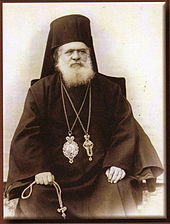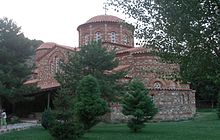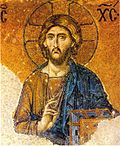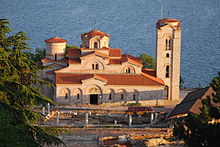- Macedonian Orthodox Church
-
For other uses, see Ohrid Archbishopric (disambiguation).
Archbishopric of Ohrid and Macedonia 
Coat of arms of the Macedonian Orthodox ChurchFounder St. Clement of Ohrid,[1] (by tradition) Independence 1019-1767 (as Archbishopric of Ohrid)[2]
self proclaimed autocephaly and independence in 1967[3]Recognition *Autonomous and restored status recognized in 1959
*autocephaly not recognized[3][4]Primate Archbishop Stephen Headquarters Skopje and Ohrid Territory  Macedonia
MacedoniaPossessions  United States
United States
 Canada
Canada
 Australia
Australia
 European Union
European UnionLanguage Old Church Slavonic and Macedonian Adherents approx. 2,000,000+ Website mpc.org.mk/ The Macedonian Orthodox Church – Ohrid Archbishopric or just Macedonian Orthodox Church (Macedonian: Македонска Православна Црква - Охридска Архиепископија; transliteration: Makedonska Pravoslavna Crkva - Ohridska Arhiepiskopija) is the body of Christians who are united under the Archbishop of Ohrid and Macedonia, exercising jurisdiction over Macedonian Orthodox Christians in the Republic of Macedonia and in exarchates in the Macedonian diaspora.
In 1959, the Holy Synod of the Serbian Orthodox Church gave autonomy to the Macedonian Orthodox Church as the restoration of the historic Archbishopric of Ohrid.[3] and remained in canonical unity with the Serbian Church under their Patriarch. In 1967, on the bicentennial anniversary of the abolition of the Archbishopric of Ohrid, the Macedonian Orthodox Church unilaterally proclaimed its autocephaly and independence from the Serbian Orthodox Church. The Serbian Holy Synod denounced the decision and condemned the clergy as schismatic. Since then, despite various Orthodox and ecumenical efforts, the autocephaly of the Macedonian Orthodox Church is not recognized by other national Orthodox churches in defense of Serbian opposition,[3] or by the Ecumenical Patriarchate of Constantinople.
Contents
History
Origins
Church of St. Sophia, Ohrid, the first synod church of the Archbishopric of Ohrid, depicted on the church's emblem
 Theodosius of Skopje (1846-1926) made several pleas to the Bulgarian Exarchate to allow the restoration of a separate Macedonian church[5]
Theodosius of Skopje (1846-1926) made several pleas to the Bulgarian Exarchate to allow the restoration of a separate Macedonian church[5]
 St. Leontine, near Strumica
St. Leontine, near Strumica
After the fall of the First Bulgarian Empire, Emperor Basil II acknowledged the autocephalous status of the Bulgarian Orthodox Church and by virtue of special royal decrees set up its boundaries, dioceses, property and other privileges. The Archibishopric was seated in Ohrid in the Byzantine theme of Bulgaria and was established in 1019 by lowering the rank of the autocephalous Bulgarian Patriarchate and its subjugation to the jurisdiction of the Patriarchate of Constantinople.[6][7] In 1767 the Archbishopric was abolished by the Turkish authorities and annexed to the Patriarchate of Constantinople. Efforts were made in 19 and the first part of 20 century to restore the Archdiocese, and in 1874 it became part of the new established Bulgarian Exarchate. The Christian population of the bishoprics of Skopje and Ohrid voted in 1874 overwhelmingly in favour of joining the Exarchate, the Bulgarian Exarchate became in control of most of the Macedonian region.
As Vardar Macedonia became part of Serbia after World War I, since 1918 and before the World War II several of the Bulgarian Exarchate's dioceses were forcefully taken over by the Serbian Orthodox Church. While the region of Macedonia was occupied by Bulgaria during World War II the local dioceses came temporarily under the control of the Bulgarian Exarchate.
Struggle for autocephaly
The very first modern assembly of Macedonian clergy was held near Ohrid in 1943.[8] In 1944 an Initiative Board for the organization of the Macedonian Orthodox Church was officially formed.[3] In 1945 the First Clergy and People's Synod met and adopted a Resolution for the restoration of the Ohrid Archbishopric as a Macedonian Orthodox Church. It was submitted to the Serbian Orthodox Church, which since 1919 had been the sole church in Vardar Macedonia. The resolution was rejected, but a later one, submitted in 1958 at the Second Clergy and People's Synod, was accepted on June 17, 1959 by the Serbian Orthodox Church under pressure from the Socialist authorities. Dositej Stojković, a Serb, was appointed the first archbishop of Ohrid and Metropolitan of Macedonia.[3] The Macedonian Orthodox Church at that time only held autonomous status.
After the Serbian Orthodox Church agreed with the decisions in the resolution, the agreement was celebrated in a common liturgy by the Macedonian priests and the Serbian Patriarch German in Skopje, a sign that the Serbian church recognized the autonomy of the Macedonian church. In 1962 Serbian Patriarch German and Russian Patriarch Alexy visited the Macedonian Orthodox Church during the feast of Saints Cyril and Methodius. It was on this occasion that the Macedonian Archbishop celebrated his first liturgy with heads of other Orthodox churches.
At its third synod in 1967, on the bicentennial anniversary of the abolition of the Archbishopric of Ohrid, the Macedonian Orthodox Church proclaimed its autocephaly and independence from the Serbian Orthodox Church. The Serbian Holy Synod denounced the decision and condemned the clergy as schismatic. Despite various Orthodox and ecumenical efforts, the autocephaly of the Macedonian Orthodox Church is not recognized by other national Orthodox churches in defense of Serbian opposition.[3]
Today
Today, the Macedonian Orthodox Church has about 1200 churches in Macedonia organized in 10 eparchies, whose bishops make up the "Holy Synod of Bishops", headed by the "Archbishop of Ohrid and Macedonia". At its session in 1994, the Holy Synod stated that
“ "The autocephalous status of the Macedonian Orthodox Church and the interest of the Macedonian people and state are holy and inalienable values, which it has no intentions of ever giving up."[3] ” After Archbishop Mihail was elected in as head of the Macedonian Orthodox Church in 1993, he stated that the church wanted to cooperate with neighboring Greek, Bulgarian, and Serbian churches. He hoped that:
“ we will find understanding after we give our true information about the restoration and autocephaly of the Ohrid Archbishopric and the activities of our dear Macedonian Orthodox Church... the Macedonians are an ancient nation, we are an ancient church, we did not create a church, we renewed our illegally abolished Ohrid Archbishopric.[9] ” The church also pays special attention in preserving the national identity and cultural traditions among Macedonian expatriates in Western countries. Many Orthodox churches who are recognized with the Ecumenical Patriarch of Constantinople admit the faithful of the Macedonian Orthodox Church to holy communion. The hierarchy of some churches serve with the Macedonian Orthodox priests, but will not serve liturgically with the hierarchy.
Relations with the Serbian Orthodox Church
 Macedonian cross - one of the symbols of the church.
Macedonian cross - one of the symbols of the church.
Since the breakup of Yugoslavia, the Serbian Orthodox Church has been seeking to restore its control over the Macedonian Orthodox Church.[9] The Macedonian church sees these efforts, supported by other Orthodox churches,[9] as closely connected to the Serbian government agenda. The main issue of dispute mainly revolves around the church's autocephaly, although there are some other minor issues including Macedonia's Serb Orthodox minority (according to the last census, there are 40,000 citizens of the country declared as Serbs) and the question of some hundreds of Serb Orthodox shrines from the medieval Nemanjić period.
The two Churches had been negotiating the details of a compromise agreement reached in Niš, Serbia in 2002, which would have given the ethnic Macedonians de facto independent status just short of canonical autocephaly. The agreement was signed and agreed upon by three Bishops in the Macedonian Orthodox Church (Metropolitan Petar of Australia, Metropolitan Timotej of Debar and Kicevo; and Metropolitan Naum of Strumica). After political officials exerted pressure on the clergy of the MOC for accepting the agreement, the Bishops later reneged on the agreement, leaving only Archbishop Jovan of Ohrid (secular name Zoran Vraniškovski) from the Macedonian side in agreement. Suddenly the signed agreement was rejected by the Macedonian government and the Holy Synod of MOC. In turn, the Serbian Orthodox Church granted full autonomy to the Orthodox Ohrid Archbishopric, its embattled branch in the Republic of Macedonia, in late May 2005 and appointed Jovan as its Archbishop.
Part of a series on Eastern Christianity 
History Orthodox Church History
Specific regions:
Byzantine Empire
Ecumenical council
Christianization of Bulgaria
Christianization of Kievan Rus'
East-West Schism
Asian Christianity
Coptic Egypt · UkraineTraditions Orthodox Church
Others:
Oriental Orthodoxy
Ethiopian Tewahedo Church
Coptic Church
Church of the East
Eastern Catholic Churches
Syriac ChristianityLiturgy and worship Sign of the cross
Divine Liturgy
Iconography
Asceticism
OmophorionTheology Hesychasm · Icon
Apophaticism
Filioque clause
Miaphysitism
Monophysitism
Diophysitism
Nestorianism
Theosis · Theoria
Phronema · Philokalia
Praxis · Theotokos
Hypostasis · Ousia
Essence vs. Energies
MetousiosisThe later chain of events turned into a vicious circle of mutual accusations and incidents involving SOC and, partly, the Serbian government on one side, and MOC, backed by the Macedonian government on the other. The Macedonian side regarded Jovan as a traitor and Serbian puppet. Jovan complained of a new state-backed media campaign against his Church. "They are creating an unstable, explosive atmosphere among the population and are virtually inviting people to lynch us," he told Forum 18 News Service.[10] The government has denied registration of his Church,[11] attacked its places of worship and launched a criminal case against him. He was arrested, removed from his bishopric and then expelled from the country. He returned in 2005 and, after attempting to perform a baptism, he was arrested, and sentenced to 18 months in prison [12] and jailed[13] with "extremely limited visitation rights".[14] On March 19, 2006, after spending 220 days in prison, archbishop Jovan was released [1].
In turn, SOC denied a Macedonian delegation access to the monastery of Prohor Pčinjski, which was the usual site of Macedonian celebration of the national holiday of Ilinden (literally meaning St. Elijah Day) on August 2 [15] and the site where the First Session of ASNOM was held. Macedonian border police often denied Serbian priests entry into the country in clerical garb.[16]
Despite public appeals from both churches for "Christian brotherhood and unity", both sides did little to settle the dispute.
Organization
As of 2005, the Macedonian Orthodox Church is headed by Archbishop Stephen of Ohrid and Macedonia. He presides over the Holy Synod of Hierarchs of the church, consisting of 9 metropolitans and titular bishops.
- Dioceses on the territory of Republic of Macedonia
- Diocese of Skopje, headed by Archbishop Stefan of Ohrid and Macedonia;
- Diocese of Polog and Kumanovo, headed by Metropolitan Kiril;
- Diocese of Debar and Kičevo, headed by Metropolitan Timotej;
- Diocese of Prespa and Pelagonia, headed by Metropolitan Petar;
- Diocese of Strumica, headed by Metropolitan Naum;
- Diocese of Bregalnica, headed by Metropolitan Ilarion;
- Diocese of Povardarie, headed by Metropolitan Agatangel
- Dioceses outside the Republic of Macedonia
- American-Canadian Diocese, headed by Metropolitan Metodij
- European Diocese, headed by Metropolitan Pimen
- Diocese of Australia and New Zealand, administered by Metropolitan Petar of Prespa and Pelagonia
Outside the country, the church is active in 3 dioceses in the diaspora. The 10 dioceses of the church are governed by ten Episcopes, with around 500 active priests in about 500 parishes with over 2000 churches and monasteries. The church claims jurisdiction of about twenty living monasteries, with more than 100 monks.
Church calendars follow the old Julian Calendar, and use the archaic names of the months of the year instead of the common Latin-derived names
Gallery
-
Monastery of Holy Mother - Kičevo
-
A small church above the Bitola dedicated to Forty Holy Martyrs of Sebaste
-
Church of St. John at Kaneo (Ohrid)
-
Millennium Cross, the largest cross in the world
-
Saint Jovan Bigorski Monastery near the city of Debar
-
Holy Trinity Orthodox church in Radoviš
See also
Footnotes
- ^ The traditional founder of the historical Archbishopric of Ohrid, whose unrecognized autocepholous status is today claimed by the Macedonian Orthodox Church
- ^ Dates of the original Archbishopric of Ohrid, an autonomous Eastern Orthodox Church under the tutelage of the Patriarch of Constantinople, whose restored autocephaly is claimed by the Macedonian Orthodox church, a move that has not been recognized by the Serbian Orthodox Church since 1967.
- ^ a b c d e f g h The encyclopedia of Christianity, Volume 3. By Erwin Fahlbusch, Geoffrey William Bromiley. p. 381
- ^ Orthodox Ohrid Archbishopric
- ^ Д-р Славко Димевски, Митрополитот скопски Теодосиј - Живот и дејност - (1846-1926), Скопје 1965, 138.
- ^ Nevill Forbes, Arnold J. Toynbee, D. Mitrany, D. G. Hogarth (2004). The Balkans: A History of Bulgaria, Serbia, Greece, Romania, Turkey. Digital Antiquaria. pp. 28–29. ISBN 1580573142.
- ^ Treadgold, Warren T. (1997). A History of the Byzantine State and Society. Stanford University Press. p. 528. ISBN 1580573142.
- ^ Macedonia and Greece: the struggle to define a new Balkan nation By John Shea, p. 174
- ^ a b c Macedonia and Greece: the struggle to define a new Balkan nation. By John Shea. P. 174
- ^ "Forum 18 Search/Archive". Forum18.org. http://www.forum18.org/Archive.php?article_id=579. Retrieved 2011-11-05.
- ^ "Forum 18 Search/Archive". Forum18.org. http://www.forum18.org/Archive.php?article_id=418. Retrieved 2011-11-05.
- ^ "IWPR Institute for War & Peace Reporting". Iwpr.net. 1980-12-25. http://www.iwpr.net/?p=bcr&s=f&o=257037&apc_state=henibcr200508. Retrieved 2011-11-05.
- ^ http://www.christianity.com/partner/Article_Display_Page/0,,PTID17865%7CCHID118517%7CCIID2063006,00.html
- ^ "Southeast Europe Online". Southeasteurope.org. http://www.southeasteurope.org/subpage.php?sub_site=2&id=14827&head=hl&site=5. Retrieved 2011-11-05.
- ^ "Press Online". Lobi.com.mk. http://www.lobi.com.mk/default-en.asp?ItemID=A24A3FEA12A7AF4795442CFA3295E658. Retrieved 2011-11-05.
- ^ "Eca 15". Hrw.org. 1999-10-31. http://www.hrw.org/wr2k/Eca-14.htm. Retrieved 2011-11-05.
External links
- Official Website
- Official Website - History
- I thank you, God (Macedonian) (English) (German)
- Premin Portal (Macedonian)
- Article on the MOC on the CNEWA website
Dioceses
- Diocese of America and Canada
- Diocese of Australia and New Zealand
- Diocese of Europe
- Diocese of Strumica - News
Churches and Monasteries
- St. Kiril i Metodij, Dortmund, Germany
- Sts. Peter and Paul, USA
- St. Stephen, Netherlands
- St. Clement of Ohrid, Germany
- St. Naum of Ohrid, Sweden
- St. Naum of Ohrid, Switzerland
- Macedonian Orthodox Cathedral of the Dormition of the Virgin Mary ("St. Mary") - Greater Columbus, Ohio, USA Oldest congregation of the American Canadian Macedonian Orthodox Diocese, chartered September 17, 1958. Please see the official records of the Ohio Secretary of State at these links: Ohio Secretary of State Business Filings
Orthodox Christianity in Europe Sovereign
states- Albania
- Andorra
- Armenia
- Austria
- Azerbaijan
- Belarus
- Belgium
- Bosnia and Herzegovina
- Bulgaria
- Croatia
- Cyprus
- Czech Republic
- Denmark
- Estonia
- Finland
- France
- Georgia
- Germany
- Greece
- Hungary
- Iceland
- Ireland
- Italy
- Kazakhstan
- Latvia
- Liechtenstein
- Lithuania
- Luxembourg
- Macedonia
- Malta
- Moldova
- Monaco
- Montenegro
- Netherlands
- Norway
- Poland
- Portugal
- Romania
- Russia
- San Marino
- Serbia
- Slovakia
- Slovenia
- Spain
- Sweden
- Switzerland
- Turkey
- Ukraine
- United Kingdom
- (England
- Northern Ireland
- Scotland
- Wales)
States with limited
recognition- Abkhazia
- Kosovo
- Nagorno-Karabakh
- Northern Cyprus
- South Ossetia
- Transnistria
Dependencies
and other territories- Åland
- Faroe Islands
- Gibraltar
- Guernsey
- Jan Mayen
- Jersey
- Isle of Man
- Svalbard
Other entities Autocephalous and Autonomous Churches of Eastern Orthodoxy Autocephalous Churches Four Ancient Patriarchates: Constantinople · Alexandria · Antioch · Jerusalem
Russia · Serbia · Romania · Bulgaria · Georgia · Cyprus · Greece · Poland · Albania · Czech Republic and Slovakia · America* · Macedonia*Autonomous Churches * Autocephaly or autonomy is not universally recognized.
** Semi-autonomous part of the Russian Orthodox Church whose autonomy is not universally recognized.Categories:- Macedonian Orthodox Church
- National churches
Wikimedia Foundation. 2010.













